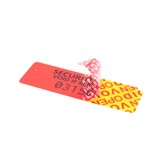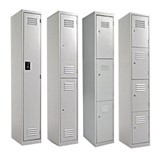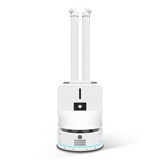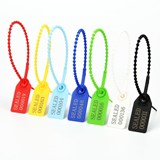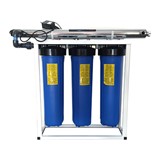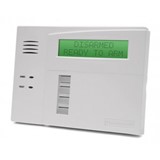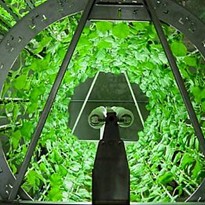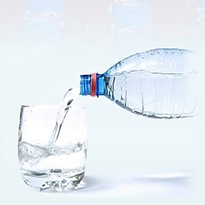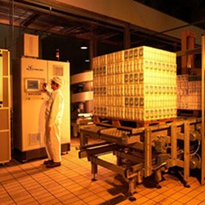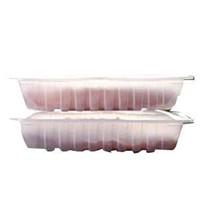In an increasingly regulated and safety-conscious market, these industries have to meet ever more stringent standards on water quality and bio-security.
It is vital to treat the water used in the manufacturing process to remove toxins, biohazards and any unwanted organic materials, while at the same time not incurring any residual taste, colour or reagents that could affect another part of the downstream process. In these industries the 'raw' potable water they source at the start of the process may not be completely free of bio-challenges, as needed for their individual processes, resulting in active growth of microorganisms to harmful levels.
UV is ideal for these applications as it is both effective and chemical-free. It eliminates all known pathogenic and spoilage microorganisms, including bacteria, viruses, yeasts and moulds (and their spores) and is low maintenance and environmentally friendly. The importance of bio-security Bio-security is very important to understand from both the supplier and customer perspective.
It is a fine balancing act between providing an appropriately-sized treatment system on the one hand while ensuring viable cost of ownership on the other.
Where a UV system is required to target a specific bacteria, virus or other bio-hazard, the precise minimum dose needed to achieve the required reduction of that hazard must be well characterised and monitored in delivery.
How UV disinfection works
UV is the part of the electromagnetic spectrum between visible light and X-rays. The specific portion of the UV spectrum between 185 400nm (known as UV-C) has a strong germicidal effect, with peak effectiveness at 265nm. At these wavelengths UV eliminates microorganisms by penetrating their cell membranes and damaging the DNA, making them unable to reproduce and effectively killing them.
A typical UV disinfection system for process water or liquid ingredient consists of a UV lamp housed in a protective quartz sleeve and mounted within a cylindrical stainless steel chamber.
The liquid to be treated enters at one end and passes along the entire length of the chamber before exiting at the other end. Virtually any liquid can be effectively treated with UV, including raw mains water, filtered process water, viscous sugar syrups, beverages and effluent.
There are no microorganisms known to be resistant to UV; this includes pathogenic bacteria such as Listeria, Legionella and Cryptosporidium (and its spores, which are resistant to chlorination).
UV dose
The UV dose necessary for microbial deactivation varies from one species to another and is measured in millijoules per square centimetre (mJ/cm2). Values for specific microorganisms have been experimentally established and are used to determine the type and size of UV system required.
The dose received by an organism in a UV treatment system is dependent on four main factors: the energy output of the UV source; the flow rate of the fluid through the treatment chamber; the transmission value (ability to transmit UV light) of the fluid being treated; and the geometry of the treatment chamber.
By optimising these criteria, a UV system can be tailored to effectively treat large or small flows, as well as viscous fluids or those containing dissolved solids and high levels of starch or sugar compounds.
UV technologies
There are two main types of UV technology based on the UV lamps used: low pressure and medium pressure. Low pressure lamps have a 'monochromatic' UV output (limited to a single wavelength at 254nm), whereas medium pressure lamps have a 'polychromatic' UV output (between 185-400nm).
As UV has no residual effect, the best position for a treatment system is immediately prior to the point of use. This ensures incoming microbiological contaminants are destroyed and there is a minimal chance of post-treatment contamination.
UV applications in the pharmaceutical, food and beverage industries
Direct contact water
Although municipal water supplies are normally free from harmful or pathogenicmicroorganisms, this should not be assumed. In addition, water from private sources such as natural springs or boreholes could also be contaminated. Any water used as an ingredient, or that comes in direct contact with the product, can therefore be a source of contamination.
UV disinfects this water without chemicals or pasteurisation. It also allows the re-use of process water, saving money and improving productivity without risking the quality of the product.
CIP (Clean-in-Place) rinse water
It is essential that the CIP final rinse water used to flush out foreign matter and disinfecting solutions is microbiologically safe. Fully automated UV disinfection systems can be integrated with CIP rinse cycles to ensure final rinse water does not reintroduce microbiological contaminants.
Filter disinfection
Reverse osmosis (RO) and granular activated carbon (GAC) are often used to filter process water, but can be a breeding ground for bacteria. UV is an effective way of disinfecting both stored RO and GAC filtered water and has been used in the process industries for many years.
GAC filters are also often used to dechlorinate process water, removing the 'off' flavours often associated with chlorine disinfection, meaning the flavour of the final product remains untainted and free from unwanted flavours or odours. Placing UV systems ahead of GAC filters used for dechlorination improves the performance of the filters and results in longer carbon runs, so decreasing operating costs.
As the usual dose for removing free chlorine is 15 to 30 times higher than the normal disinfection dose, an important additional benefit of using UV dechlorination is a high level of UV disinfection, reduction in Total Organic Carbon (TOC) and improved overall water quality at point-of-use.
TOC reduction
Short UV wavelengths (below 200nm) are highly effective at breaking down organic molecules present in water, commonly known as Total Organic Carbon (TOC), especially low molecular weight contaminants. This works in two ways: the first method is by direct photolysis, when energy from the UV actually breaks down chemical bonds within the organics; the second method is by the photolysis of water molecules, splitting them to create charged OH- radicals, which also attack the organics.
Cooling media and chiller disinfection
Some meat and dairy products are subject to contamination after heat treatment or cooking. UV provides an excellent way to protect foods from contamination by contact-cooling fluids.
Sugar syrups
Sugar syrups can be a prime breeding ground for microorganisms. Although syrups with very high sugar content do not support microbial growth, any dormant spores may become active after the syrup has been diluted. Treating the syrup and dilution water with UV prior to use will ensure any dormant microorganisms are deactivated.
Liquid sweeteners
Sucrose-based sweeteners can be a prime breeding ground for microorganisms. UV systems are available specifically for treating these syrups.
De-aerated liquor
De-aerated liquor is added as part of a high gravity brewing process, often in the packaging operation. This liquor is added directly to the beer so needs to be kept free from contamination by gram negative bacteria, which can cause off-flavours and acidity.
Yeast preparation
The problems associated with yeast preparation in breweries are well recognised and include hazes, altered fermentation and surface membranes on packaged beer. A single cell of Sacchoromyces (var. Turbidans) in 16 million cells of pitching yeast will cause detectable hazes. UV destroys all known yeasts and their spores.
Waste water
Effluent from pharmaceutical, food and beverage facilities can be treated without the use of environmentally hazardous chemicals. This ensures all discharges meet with local environmental regulations. As already mentioned, because process water can be treated and re-used with UV, this also leads to a significant reduction in the amount of waste water produced.
Conclusion
Meeting the increasingly rigorous hygiene standards required in the production of pharmaceutical, food and beverage products is a real challenge. If improvements need to be made to plant and equipment, they need to bring quick returns on the investment and measurable improvements in product quality.
For manufacturers seeking to improve the quality of the end product and to ensure the biosecurity of their process, UV is an economic, realistic option. It is already an established method of disinfecting drinking water throughout the world, and is already widely used for high purity applications where water of the highest quality is essential.
UV disinfection systems are easy to install, with minimum disruption to the plant. They need very little maintenance, the only requirement being replacement of the UV lamps every 9 - 12 months, depending on use. This is a simple operation that takes only a few minutes and can be carried out by general maintenance staff.
- Suppliers
- New to IndustrySearch? Book a Demo
- Advertise with us
- Login
- Email Marketing
- Buyers
- Get Quotes
- Articles & Ideas
- Login
- Subscribe to newsletter
- My Details
- Get Quotes
- Automation & Control
- Automotive Workshop Equipment
- Cleaning Equipment
- Construction & Heavy Machinery
- Conveyor Systems & Components
- Cranes & Hoists
- Electrical & Power Generation Equipment
- Electronic Components
- Farming & Agriculture
- Food & Beverage Processing
- Forklifts & Attachments
- Hydraulic & Pneumatic Equipment
- Industrial Materials, Tools & Components
- Industrial Pumps
- IT Hardware & Industrial Computing
- IT Software & Applications
- Laboratory Equipment & Instruments
- Manufacturing & Industrial Equipment
- Material Handling & Lifting
- Metalworking & Machining
- Mining Equipment & Machinery
- Packaging & Labelling Machinery
- Pallet Management
- Personal Protective Equipment
- Security & Surveillance
- Test & Measurement
- Transport Equipment
- Trucks & Trailers
- Warehouse Storage & Racking
- Waste & Environmental Management
- Welding Machines & Accessories
- Woodworking & Joinery Machines
- Workplace Equipment
- Workplace Safety Equipment
- Get Quotes
- Automation & Control
- Automotive Workshop Equipment
- Cleaning Equipment
- Construction & Heavy Machinery
- Conveyor Systems & Components
- Cranes & Hoists
- Electrical & Power Generation Equipment
- Electronic Components
- Farming & Agriculture
- Food & Beverage Processing
- Forklifts & Attachments
- Hydraulic & Pneumatic Equipment
- Industrial Materials, Tools & Components
- Industrial Pumps
- IT Hardware & Industrial Computing
- IT Software & Applications
- Laboratory Equipment & Instruments
- Manufacturing & Industrial Equipment
- Material Handling & Lifting
- Metalworking & Machining
- Mining Equipment & Machinery
- Packaging & Labelling Machinery
- Pallet Management
- Personal Protective Equipment
- Security & Surveillance
- Test & Measurement
- Transport Equipment
- Trucks & Trailers
- Warehouse Storage & Racking
- Waste & Environmental Management
- Welding Machines & Accessories
- Woodworking & Joinery Machines
- Workplace Equipment
- Workplace Safety Equipment
Trusted by 1.4 million Australian industrial buyers
Buyers
- Discover products & solutions
- Login
- Subscribe To Newsletter
- Browse All Products
- Read Articles
Suppliers
Advertise
- Promote your products & solutions
- New to IndustrySearch? Book a Demo
- Login / Forgot Password
- Advertise Your Products
- Success Stories
- Email Marketing
- Suppliers
- Advertise with us
- Login
- Email Marketing
- Buyers
- Get Quotes
- Articles & Ideas
- Login
- Subscribe to newsletter
- My Details
Get Quotes
- Automation & Control
- Automotive Workshop Equipment
- Cleaning Equipment
- Construction & Heavy Machinery
- Conveyor Systems & Components
- Cranes & Hoists
- Electrical & Power Generation Equipment
- Electronic Components
- Farming & Agriculture
- Food & Beverage Processing
- Forklifts & Attachments
- Hydraulic & Pneumatic Equipment
- Industrial Materials, Tools & Components
- Industrial Pumps
- IT Hardware & Industrial Computing
- IT Software & Applications
- Laboratory Equipment & Instruments
- Manufacturing & Industrial Equipment
- Material Handling & Lifting
- Metalworking & Machining
- Mining Equipment & Machinery
- Packaging & Labelling Machinery
- Pallet Management
- Personal Protective Equipment
- Security & Surveillance
- Test & Measurement
- Transport Equipment
- Trucks & Trailers
- Warehouse Storage & Racking
- Waste & Environmental Management
- Welding Machines & Accessories
- Woodworking & Joinery Machines
- Workplace Equipment
- Workplace Safety Equipment
Get Quotes
- Automation & Control
- Automotive Workshop Equipment
- Cleaning Equipment
- Construction & Heavy Machinery
- Conveyor Systems & Components
- Cranes & Hoists
- Electrical & Power Generation Equipment
- Electronic Components
- Farming & Agriculture
- Food & Beverage Processing
- Forklifts & Attachments
- Hydraulic & Pneumatic Equipment
- Industrial Materials, Tools & Components
- Industrial Pumps
- IT Hardware & Industrial Computing
- IT Software & Applications
- Laboratory Equipment & Instruments
- Manufacturing & Industrial Equipment
- Material Handling & Lifting
- Metalworking & Machining
- Mining Equipment & Machinery
- Packaging & Labelling Machinery
- Pallet Management
- Personal Protective Equipment
- Security & Surveillance
- Test & Measurement
- Transport Equipment
- Trucks & Trailers
- Warehouse Storage & Racking
- Waste & Environmental Management
- Welding Machines & Accessories
- Woodworking & Joinery Machines
- Workplace Equipment
- Workplace Safety Equipment
Trusted by 1.4 million Australian industrial buyers




